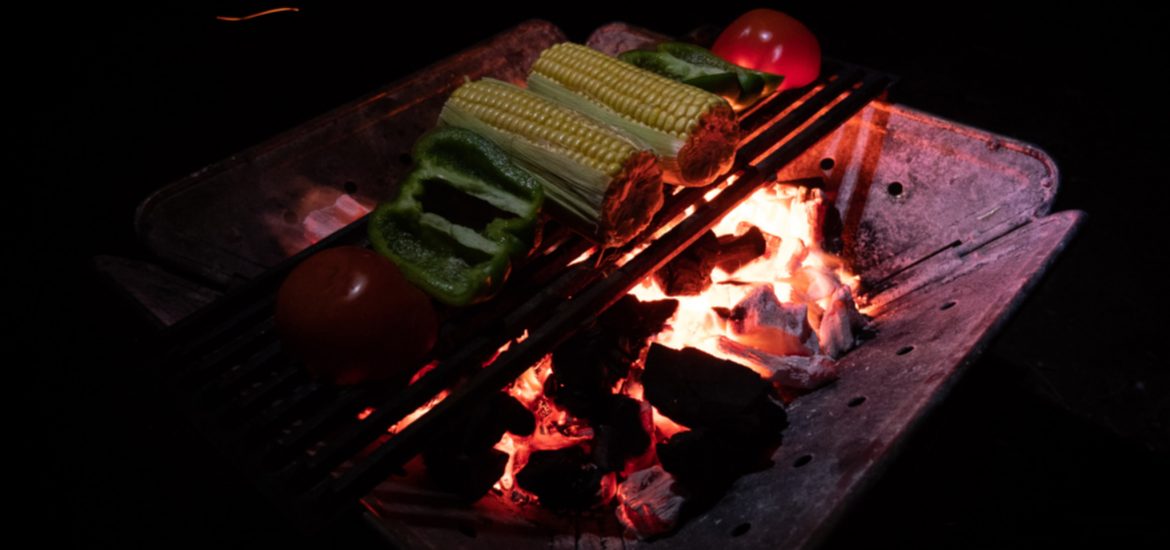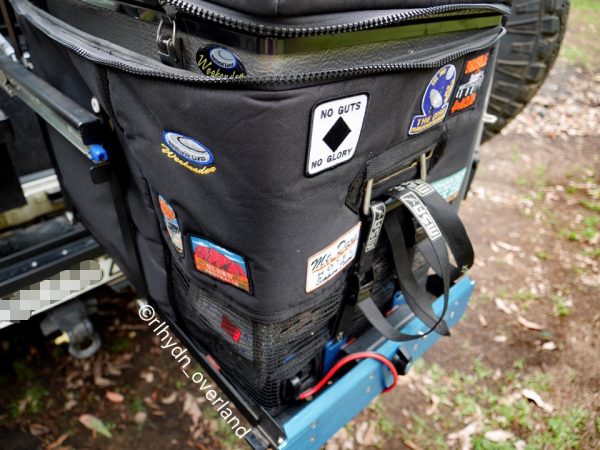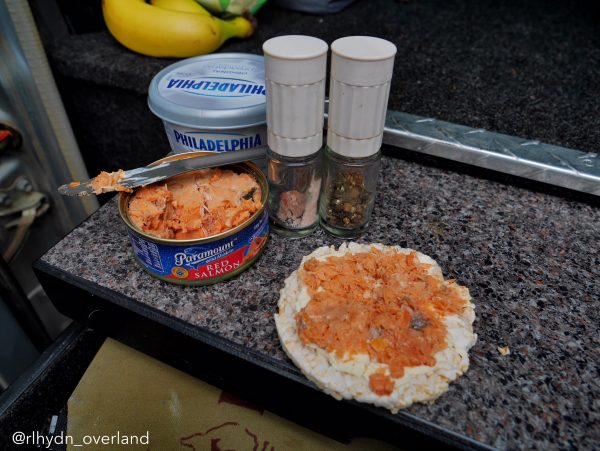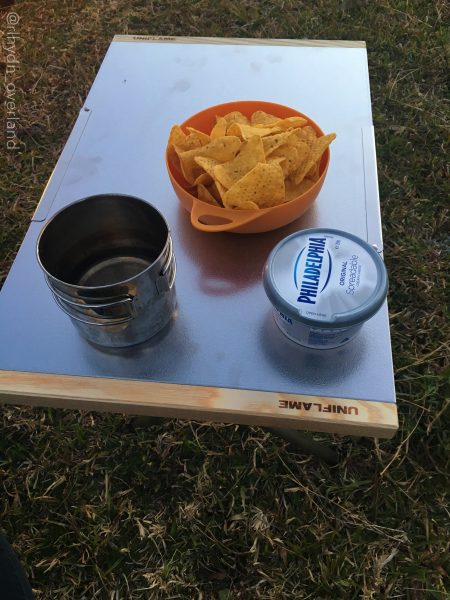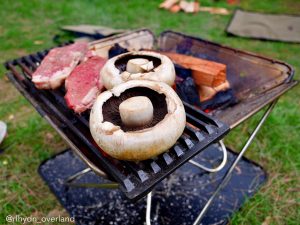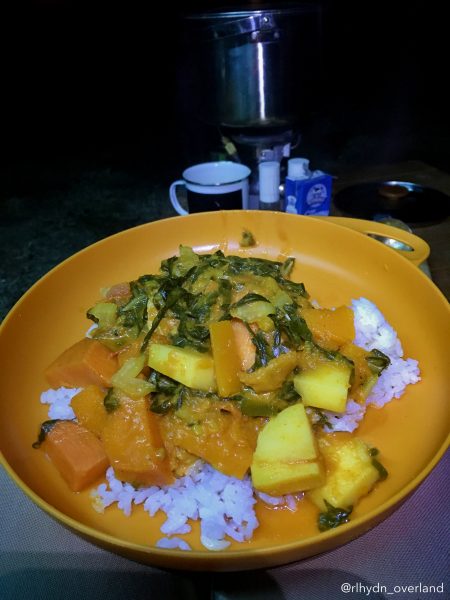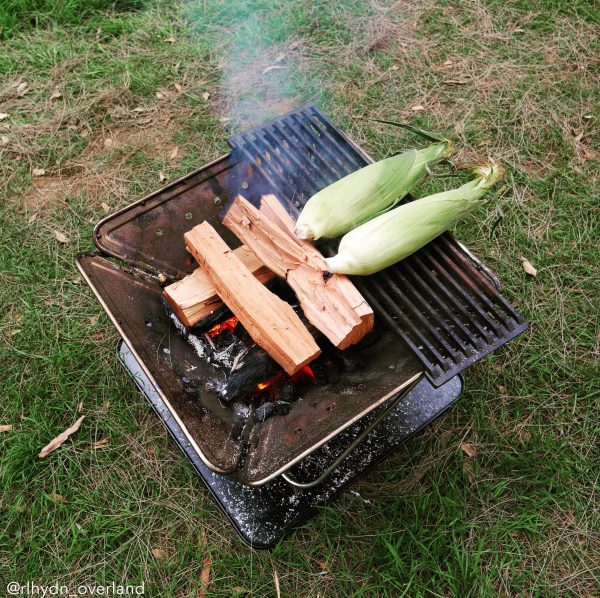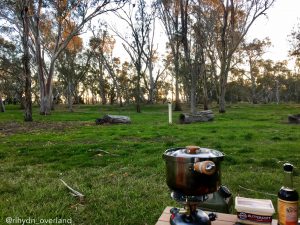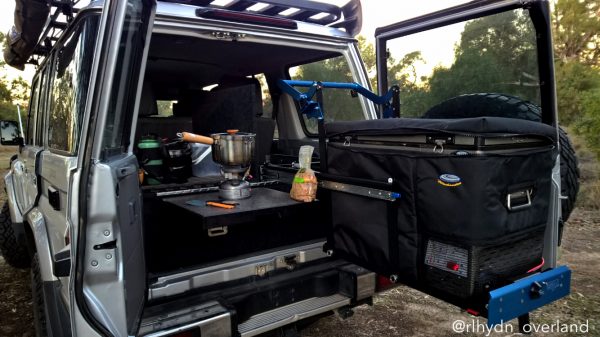My relationship with food is probably as binary as eating.
I either am or I am not. So if I am cooking, I am all over it. Loving it as much as the mess I am going to hate afterwards. Aiming for over-achievement, as if there is a gold star sticker on the line. Translating this to the camp kitchen has been a process of confidence rather than compromise,. Excluding the lack of dishwasher I suppose.
The camping cycle for me is essentially Safety – Shelter – Food, each as entwined as they are paramount above all else when isolated from so-called civilisation.
Where is the sun, (or my headlamp), what do we need to do which is governed by night and day? Am I warm, cold, wet, in bed, in the chair, prostrate on a tarp or blanket, in front of the fire or huddled under the awning with a book or task? Am I hungry, will I cook, what I will cook, how will I cook it……
Even though I am regularly trying new recipes or methods, I’ve realised that our cache of food and equipment has stabilised a little into a core arsenal or habit, and that there are only a few points of difference between touring and weekending.
To keep this on track, this will be an outline of three main meals, that have worked for us, and I will keep to the solar cycle.
Breakfast for me is mostly for the enjoyment rather than breaking my fast, preferably I would fast until late morning or lunch, unless or until I am hungry. If I feel like making a banquet to supplement the glorious surroundings we find ourselves in – I will.
Generally the dry goods cache in this respect would contain Gluten Free WeetBix, long life milk, these days an oil-free Almond variety, raw sugar and/or honey.
This provides a very quick breakfast, especially helpful if we’re packing up to continue our tour. I remember the flies in the Simpson Desert would start just before sunrise, so our pack-up quickly tuned to an efficient symphony of moves that had the Oztent empty and collapsed, breakfast in hand and minimal flies consumed.
This also ensured minimal clean-up, for us a spray bottle of eco-friendly cleaning spray and roll of paper towel (hanging on the back door for convenience served as washing up. The used paper towel goes into the wheelie bag, which can be burned if we had a fire later.
Another option for us is Greek yogurt and granola or fruit, like any of the fresh foods mentioned in this blog, they are dependent on how far we are from home, or progressed into the trip as to what’s in our fridge. Yogurt would have to be one of the first items to be eaten or even culled from the fridge before leaving in lieu of vegetables, but if we carry it…. it’s basically breakfast and desert in one delicious tub. Cue the warmed tin of apples and cinnamon….
If we’re in the mood, and settled either for a late depart or a longer stay. It is pretty hard to beat bacon and eggs in their many, many formats.
More often than not, I have a stash of streaky bacon in the National Luna 50L Weekender for three reasons. Our favourite is a wood-smoked Canberra source. It packs up and fries up small and flat and adds a good punch of flavour to add to other meals, and tastes bloody amazing.
Eggs; well they’re full of everything good and last ages in stable temperatures. Duck eggs more so. On recent trips I have opted for duck eggs as they’re tougher shelled to travel with also.
My bacon and egg go-to is pretty easy, salad on the plate, topped with hot bacon and eggs cooked together on the Coleman Sportster in the Snow Peak frypan
Salad; usually a generic term that sends folks to sleep but to me it could be just about anything.
Rocket and/or baby spinach, kale leaves, tomatoes, pickles, grated cheese and carrot, capsicum are the usual suspects for us.
I have a stash of local balsamic vinegar and olive oil in old Tupperware pourers to make a dressing too, usually a combination splash of both, with salt and pepper and chopped shallots or chives. Shallots or chives are usually part of my fresh food staple but the salt and pepper live in the LandCruiser in Snow Peak grinders, smaller than your average spice jar, they’re just beautiful to use.
If there are any, I have dug out any leftover meat or veggies from the night before to reheat and complement the eggs. Save having to store and carry it. I will slice it up smaller throw it in the fry-pan with the rest to heat up.
A real favourite but often short-lived as we can’t not eat them, is a good old $2 bag of Lebanese flat bread, we opt for the Salt, Flour, Water and Oil with no Sugar variety that lasts forever and can also double as pizza bases. Wrapping up bacon and eggs with some spinach and grated cheese is rather heavenly.
Bonus of this option is the lack of dishes, besides the frypan and spatula.
Speaking of washing up, we’ve found that if we keep the Coleman burning and swap out the fry-pan for the Snow Peak kettle, we can boil some water while we eat for the washing up. The fry-pan is mild steel so never truly gets ‘cleaned’ so far as it is seasoned. But it gets a scrub with mild eco detergent and a brush before air drying.
It goes without saying that either one of those breakfast options goes with a coffee or tea.
I can barely consider lunch after that breakfast but if not it’s usually a simple fare for us.
Unless that is, we’re coming up to a town or roadhouse, at which point it’s limited only by the menu. Stopping in allows for a sometimes a quick chat with the locals, a forced break away from the LandCruiser and injects cash into the local economy.
If we’re camped it might be another salad combination, but with tinned salmon or a cook up of sausages.
If we’re on the road one of our favourites is rice cakes, Philadelphia cheese and tinned salmon, or just cheese and tomato.
Between now and dinner, is probably our witching hour. If camped it’s worse, if I am reading a book, worse still. There is something about sitting about a fire or hunched over someone else’s life in words that inspires my appetite.
Our go to snack would be plain original corn chips (or crumbs after the corrugations) dipped in Philadelphia cheese.
The same corn chips, eaten with a serving of cheeses (my Kryptonite), tomatoes, pickles, jalapenos. One of our two Sea to Summit dinner plates serves for a platter.
By the time we feel like dinner it might be a substantial or basic affair, dependent on the weather, our locale or how much we binged earlier.
If the weather is ideal and we have wood for a fire, the Snow Peak Firepit is now comfortably a part of the kitchen. Since the non-committal (but since donned ingenious) purchase of a Gasmate cast iron grill for it, it has hosted mushrooms, steaks, chicken breasts, lamb chops, sausages, capsicums, whole corn cobs, the Snow Peak camp-oven roasted lamb and countless billies for hot chocolate; both at camp and at home.
I definitely under estimated how much I would enjoy cooking on this. We used to wrap all kinds in foil or use the camp oven occasionally in the ground fire but the fire pit adds a new level. It’s easier and efficient. But more importantly, for us, it doesn’t leave a mess after we leave.
Needless to say, our fridge is usually stocked with any combination of those meats and fresh vegetables from our local grocer. The remaining room is reserved for cheese, butter, more cheese. We also carry a stash of Campers Pantry dehydrated vegetables, super lightweight, no fridge and taste good.
If not for a char infused cook up on the naked flames, sometimes I sit and chop up everything I have and put it in the Snow Peak saucepan for the Coleman to simmer. My golden rule is about my meals is colour, and I am always aiming for the rainbow.
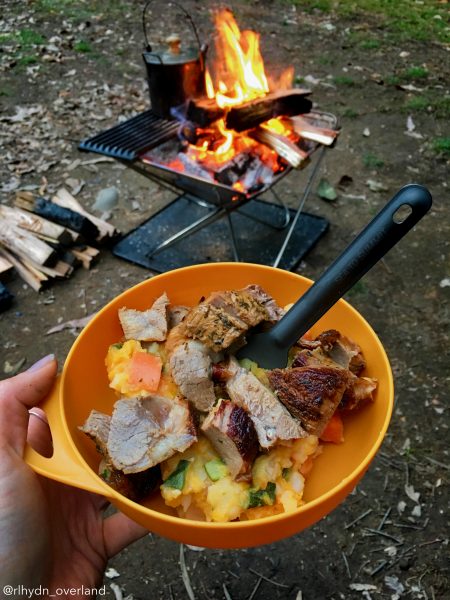
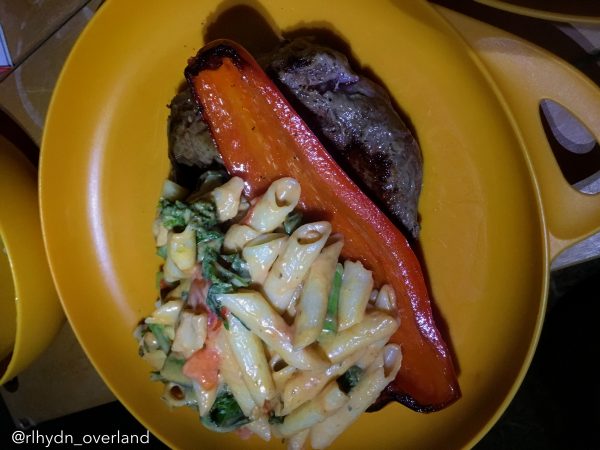
Corn tastes good grilled in or outside the husk, smokey and pop-corn-like without or perfectly steamed within. Lashings of butter required to serve either way.
Everything else is simply salt and pepper, sometimes garlic infused olive oil. I did knock up a basting sauce to make a sticky Mexican inspired chicken breasts; made a mess but tasted bloody good with creamy roasted sweet potato. I need to recall that recipe!
My seasoning for this stir-fry / casserole / sauté / goulash is generally only butter, tomato paste, herbs and spices, Worcestershire sauce, honey. Sometimes, I will stir in coconut milk or sour cream for a creamier alternative. Rice is probably the handiest side-dish and filler. Pasta tastes ok but its bulky to pack raw. I generally throw a small amount of rice into the goulash or cook more of it absorption method in a pot. I like the re-cooked packets, especially the brown rice as it doesn’t have any oil or weird additives, but it is expensive and no more than four serves – creates more rubbish than a bag of raw. Its advantage is the lack of water it requires to be cooked.
Essentially I find that a good herb and spice cache and tomato paste can give us any number of dishes, like any recipe – the composition can change its mood entirely.
I have a decent collection of spices and try to carry fresh herbs and shallots but the dried suffice also. Things like curry, cumin, coriander, cardamom, cinnamon, chilli and ginger can cook up an Indian inspired dish, or switch up the ratio for Thai or Mexican flavour. Italian and Mixed dried herb premixes make for an easy herb crust on the roast meats or into the casserole / goulash / sauté if no fresh is available.
If I was more prepared, I would create some labelled premixed containers of these combinations, just for ease and efficiency. Mainly because I am a messy cook and need all the help I can get. But non-mixed also frees up the pantry cache to suit our whimsical appetites.
This sort of leads to pre-cooking, which I love doing. The amount of vegetables you can ‘hide’ in a slow cooked casserole or meat sauce to be reheated later on the trail is criminal. Not to mention the time saved. Sometimes I want to enjoy my own, or a level of cooking similar without the time and effort. Like bolognese in a resealable vacuum bag ready to reheat and reseal on the road.
This is obviously the origin story of the dehydrated meals you can purchase today, but mass production, weight and shelf life obviously has its cost. There are some newer brands on the market that promise to deliver the taste and nutrient value without so much of the additives. In the everlasting battle for weight in the LandCruiser, I encompass these in our pantry, presuming they qualify on the above criterion that is.
2000 introductory words on why and how I love food on the trail. I’ve earnt myself some triple cream brie surely?
If you want more information on what helps us keep the worms fed at our campsite, check out www.drifta.com.au for Snow Peak, www.camperspantry.com.au for their dehydrated food, www.colemanaustralia.com.au for stoves, www.seatosummit.com.au for camp kitchenalia and www.nationalluna.com.au for my most favourite fridge in the world.
